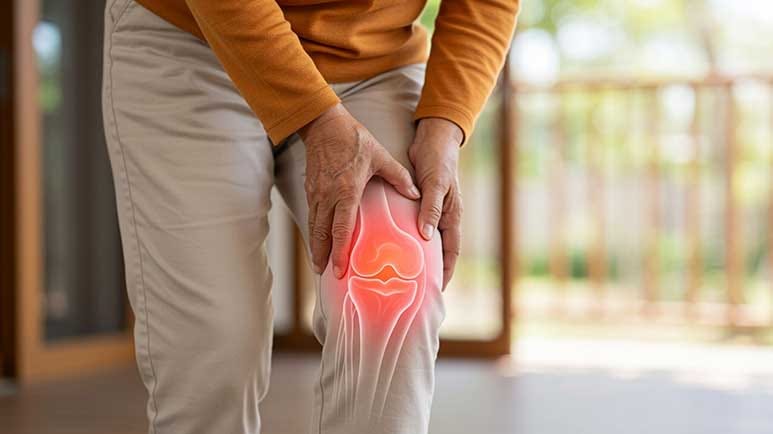Knee and Groin Pain Could Signal Hip Problems
Description
STORY AT-A-GLANCE
Many people mistake groin or knee pain for local strain or joint issues when the real source is the hip, delaying proper treatment
The brain sometimes misinterprets signals from shared nerve pathways, causing hip pain to be felt in the knee, thigh, or groin. This phenomenon is known as referred pain
Bone density loss and early signs of osteoarthritis are affecting people in their 20s and 30s due to sedentary lifestyles and poor nutrition. This increases their risk of hip problems later in life
Many people push through pain rather than seeking help, leading to more severe joint damage over time
Combining medical treatments, physical therapy, proper nutrition, supplements, and lifestyle changes leads to more sustainable healing and pain relief

Have you ever felt a stubborn ache in your groin, thigh, or knee and chalked it up to a pulled muscle or the result of daily wear and tear? You’re not alone — and you might be missing the real culprit. Pain can be like a faulty GPS, sending you in the wrong direction and making it hard to pinpoint the true source. A sore knee might not indicate a joint issue, and groin discomfort may not stem from overexertion.
Surprisingly, these aches can signal trouble with one of the body’s most important weight-bearing joints — the hip. The hip is a powerful central joint that powers nearly every movement. When it starts to wear down, the pain starts to spread to unexpected areas in the body. And because discomfort doesn’t always start in the hip, the pain often leads to misinterpretation.
Public Misunderstanding of Hip-Related Pain
To understand how common this misunderstanding is, researchers at The Ohio State University Wexner Medical Center recently launched a national survey1 to reveal just how people commonly misread their body’s pain signals.
Their goal is to identify the link between hip health and pain in other areas of the body by assessing the participants’ ability to recognize the signs of hip problems. Their findings suggest that many Americans are misinterpreting symptoms, which could lead to delays in proper diagnosis and treatment.2
The survey involved a sample size of 1,004 adults aged 18 and above — It revealed that 72% didn’t know knee pain could signal a hip issue, while 69% overlooked groin pain, and 66% missed thigh pain as a possible sign of hip-related problems.
Signs of hip problem that are often underrecognized — While some participants did recognize indicators such as clicking in the hip, difficulty bending, or tying shoes, others overlooked symptoms such as lower back pain, night pain, and trouble sleeping. The researchers advise consulting a medical expert to correctly diagnose any unexplained pain.
Many people try to manage their discomfort on their own — Four in 10 people push through the pain, while 52% rely on over-the-counter medications instead of seeking a proper diagnosis. This highlights a cultural tendency to ignore discomfort until it becomes severe.3
“Patients will be referred to me for knee pain. When I examine the patient, I will rotate their hip, and the patient will feel pain. We'll also do X-rays to determine arthritis in the hip and if a replacement would be beneficial,” says Dr. Matthew Beal, orthopedic surgeon and associate professor at Ohio State.
The survey findings underscore how easily hip issues can masquerade as pain elsewhere in the body. This disconnect is rooted in a medical phenomenon known as “referred pain.”
Demystifying Referred Pain
The Pennsylvania Pain and Spine Institute describes referred pain as a misunderstood condition where pain is felt in one area of the body, even though the source is elsewhere. This can lead to treatments being ineffective by targeting the wrong area, leaving the root cause unresolved and prolonging discomfort.4
How it happens — Referred pain occurs when the brain misinterprets signals from the body regions that share similar nerve pathways. Because these multiple body regions send signals to the same spinal segment, the brain may “project” pain to a more familiar or superficial area.
Hip-related referred pain — The hip joint, due to its proximity and shared nerve connections with the lower back, groin, buttock, thigh, and knee, can cause pain in these areas even when the hip doesn’t feel sore. This is common in cases of degenerative osteoarthritis. Common signs of hip-related referred pain include:
Groin pain
Limping or changes in gait
Pain that worsens at night after prolonged sitting
Discomfort radiating to the thigh or knee
<label class="hide-text" contenteditable="false">Text within this block will maintain its original spacing when published</label>Other hip conditions that can cause referred pain include:
Sacroiliac joint issues
Piriformis syndrome
Avascular necrosis of the hip
Hip impingement syndrome
Mapping out solutions and treatments — Careful evaluation is essential, especially for those with chronic lower back pain, to ensure the hip is not overlooked. Once the hip is confirmed as the source of referred pain, treatment options may include physical therapy to correct imbalances and advanced therapies like platelet-rich plasma (PRP) injections. Anti-inflammatory drugs are also often prescribed, but they don’t address the root cause and often come with side effects.
Doctors may use X-rays or MRI scans to help confirm a hip diagnosis. In some cases, diagnostic injections are performed — if the injections relieve both hip and referred pain, it confirms the hip as the source. This helps guide treatment so patients can avoid unnecessary procedures that target the wrong area.
Other Causes of Knee and Groin Pain
While hip-related referred pain is the common culprit, an article in Health Central emphasizes that knee and groin pain stem from a variety of overlapping conditions, including:5
Muscle strain — Overuse or injury to the iliopsoas muscle, the primary hip flexor responsible for bending and rotating the hip, can cause groin-to-knee pain. Activities like weight training, sports, or running often trigger this type of strain. Treatment usually involves rest and physical therapy, with most cases reso






